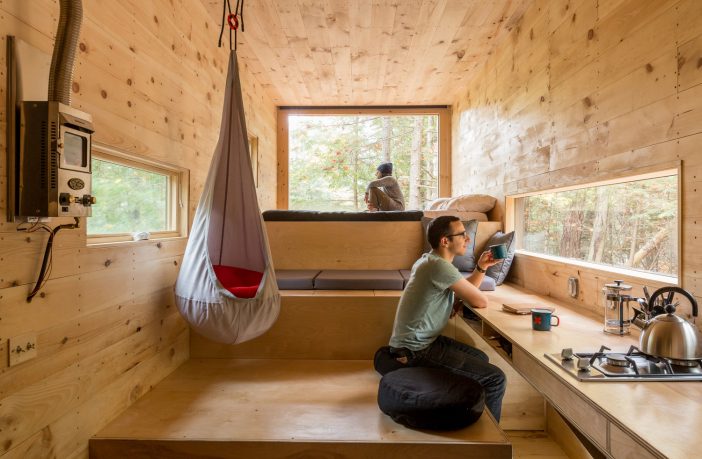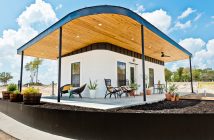- The dream of a home in the suburbs with a white picket fence is changing.
- Between housing crises and homelessness, mounting debt and downsizing, home ownership has become increasingly less attainable.
- The tiny house movement is a direct response to these forces, with cities and designers asking whether micro dwellings can address pressing issues or if they are glorifying unhealthy living conditions.
To complicate things, tiny homes come in many sizes, and can actually be illegal in some places. In the United States, tiny houses are difficult to regulate when it comes to zoning and safety, and states can deem them unacceptable as forms of residency. The law looks at tiny houses as something between camper vans, mobile homes, and traditional single-family residences. They can be micro-apartments and office spaces to cabins on wheels. But to officially be “tiny,” the house has to be 400 square feet or less according to the International Code Council. Tiny homes also come in two different types: movable (on wheels) or stationary (on a foundation).
While there are many problems, tiny homes can also provide a range of benefits, from a minimalist lifestyle and mobility to lower costs when compared to traditional single family homes. But are they truly an answer to urban inequality, or capitalizing on the needs of a growing demographic? The following articles explore the tiny house movement and where these questions may be headed.
A Tiny Luxury: What are “Tiny Houses” Really Saying About Architecture?
Following a successful pilot launch in Boston and $1 million in venture backing, a startup company called Getaway has recently launched their service to New Yorkers. The company allows customers to rent out a collection of designer “tiny houses” placed in secluded rural settings north of the city; beginning at $99 per night, the service is hoping to offer respite for overstimulated city folk seeking to unplug and “find themselves.” The company was founded by business student Jon Staff and law student Pete Davis, both from Harvard University, out of discussions with other students about the issues with housing and the need for new ideas to house a new generation. From that came the idea of introducing the experience of Tiny House living to urbanites through weekend rentals.
5 Things Architecture Can Learn from the Tiny House Movement
As the global economy grows uncertain, homeowners are getting more creative in order to afford essential residential spaces. The tiny house movement has gained a foothold worldwide, encouraging the construction of homes as small as 150 square feet (14 square meters), with many smaller housing models cropping up on a daily basis. Home to residents of all ages, tiny houses have evolved far beyond the cramped quarters of Airstream trailers of decades past and, though they were once considered an architectural farce, tiny houses are becoming an increasingly popular solution to weather the economic storm and increasingly relevant to the field of architecture.
Tiny-House Villages: Safe Havens for the Homeless
As the need for smart housing solutions rises, so does the appeal of tiny-house villages, not just as shelter for the homeless, but as a possible look to the future of the housing sector. The new article, Are Tiny-House Villages The Solution To Homelessness? by Tim Murphy, takes a closer look into the positive and negative aspects of these controversial communities, as well as their social and political ramifications so far. Through interviews with residents of several tiny-house villages, Murphy investigates the current impacts they have had on the homeless populations within major American cities, and questions how the lifestyle will evolve in the future. Read the full article, here.
Micro-Architecture: 40 Big Ideas for Small Cabins
In spite of their apparent simplicity, small cabins have always been a welcome design challenge in which scale, materiality and habitability must be resolved in order to take maximum advantage of minimal spaces. Perhaps the most famous exercise in cabin design, the Le Corbusier-designed 16m2 cabanon was a container of ideas in which the Swiss architect explored the “modulor”– an understanding of the fundamentality of human scale. In the ensuing half-century, many prominent architects have ventured into cabin design both experimentally and at a primitive level, especially as a small refuge in harmony within a natural context.
Author: Eric Baldwin
This article was first published in Arch Daily and is republished with permission.
Clean drinking water is becoming increasingly scarce. Do your bit to save water. You can start by retrofitting your tap and shower mixers at home with Hansgrohe EcoSmart technology.
Visit the Hansgrohe Showroom in Johannesburg to see the Rainfinity range in action.
Find a Hansgrohe Retail Store near you . Hansgrohe is present in South Africa, Madagascar, Nigeria, Kenya, Botswana, Seychelles, Mauritius, Namibia, Tanzania, Zimbabwe, Ghana and Zambia.



















1 Comment
Stop building houses on trailers and calling them tiny homes. They are trailer houses or RVs. Build a tiny home like a site built home. Tiny slab tiny framing tiny walls then you have a tiny home. The wheels are CRAP!